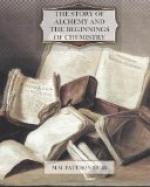When the student of chemistry desires to effect the transformation of one definite substance into another, he is told to determine, by quantitative experiments, what are the elements, and what the quantities of these elements, which compose the compound which he proposes to change, and the compound into which he proposes to change it; and he is given working definitions of the words element and compound. If the compound he desires to produce is found to be composed of elements different from those which form the compound wherewith his operations begin, he is directed to bring about a reaction, or a series of reactions, between the compound which is to be changed, and some other collocation of elements the composition of which is known to be such that it can supply the new elements which are needed for the production of the new compound.
Since Lavoisier realised, for himself, and those who were to come after him, the meaning of the terms element and compound, we may say that chemists have been able to form a mental picture of the change from one definite substance to another, which is clear, suggestive, and consistent, because it is an approximately accurate description of the facts discovered by careful and penetrative investigations. This presentment of the change has been substituted for the alchemical conception, which was an attempt to express what introspection and reasoning on the results of superficial investigations, guided by specious analogies, suggested ought to be the facts.
Lavoisier was the man who made possible the more accurate, and more far-reaching, description of the changes which result in the production of substances very unlike those which are changed; and he did this by experimentally analysing the conceptions of the element and the compound, giving definite and workable meanings to these conceptions, and establishing, on an experimental foundation, the generalisation that the sum of the quantities of the substances which take part in any change is itself unchanged.
A chemical element was thought of by Lavoisier as “the actual term whereat analysis has arrived,” a definite substance “which we cannot subdivide with our present knowledge,” but not necessarily a substance which will never be divided. A compound was thought of by him as a definite substance which is always produced by the union of the same quantities of the same elements, and can be separated into the same quantities of the same elements.
These conceptions were amplified and made more full of meaning by the work of many who came after Lavoisier, notably by John Dalton, who was born in 1766 and died in 1844.
In Chapter I., I gave a sketch of the atomic theory of the Greek thinkers. The founder of that theory, who flourished about 500 B.C., said that every substance is a collocation of a vast number of minute particles, which are unchangeable, indestructible, and impenetrable, and are therefore properly called atoms; that the differences which are observed between the qualities of things are due to differences in the numbers, sizes, shapes, positions, and movements of atoms, and that the process which occurs when one substance is apparently destroyed and another is produced in its place, is nothing more than a rearrangement of atoms.




